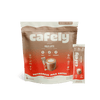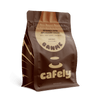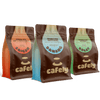Keeping track of your coffee intake can be frustrating, especially as each coffee cup is a different size and shape. These factors make “a cup of coffee” much more complicated than it seems.
In this guide, we break down everything you need to know, ounce by ounce, so you can measure your coffee intake with confidence.
How Many Ounces Are in a Cup of Coffee?
We’re used to measuring the water and ground coffee that goes into the brew, but how much we actually drink is rarely considered.
Here’s everything you need to know:
1. A Standard Cup of Coffee
In the US, asking for a standard cup of coffee in most diners, restaurants, or cafes will get you six ounces (240 mL) of coffee — not an awful lot of liquid. This measurement provides room for cream and sugar.
Some restaurants may have started using this smaller six-ounce size because they offer free coffee refills. If customers are used to having two mugs of coffee with their breakfast at home, they will likely emulate that while eating out. With slightly smaller cups, the restaurant doesn’t use as much coffee, which may reduce the potential for waste.
2. Chain Coffee Sizes

While six ounces is the standard coffee size for most stores throughout the US, most coffee chains have their own sizes. The most popular chain is Starbucks.
Here’s a lineup of their different drink sizes:
- Demi — 3 oz (88 mL)
- Short — 8 oz (240 mL)
- Tall — 12 oz (350 mL)
- Grande — 16 oz (275 mL)
- Venti — 24 oz (710 mL)
- Trenta — 31 oz (920 mL)
When you order a cup of coffee at Starbucks, the barista will always ask which size you would like. A short at eight ounces is your best bet if you want to go for the closest to the standard six-ounce cup.
3. The Other Types of Cups and Ounces
Another reason the six-ounce cup of coffee may be a bit surprising is that a cup is already a measurement in the US. One cup is a volumetric measurement, most commonly used in baking, and comes in at eight ounces.
Of course, there are also different types of ounces, making things even more complex. Here, we’ll be using the word “ounce” to refer to the US fluid ounce, which is a volumetric measurement based on a standard US gallon. This measurement is consistent in the catering industry — it’s used in bakeries, diners, coffee shops, and restaurants.
Why Should You Track Your Coffee Intake?
If you’re concerned about how much coffee you’re drinking in your day-to-day life, you should start measuring your intake.
Let’s break down some of the reasons it’s a good idea to track your coffee intake:
How Much Coffee Is Safe to Drink?
According to the FDA, a safe amount of caffeine is anything up to 400 mg of caffeine per day. Coffee contains (roughly) 11.8 mg of 11.8 mg of caffeine per fluid ounce, so a standard six-ounce cup contains just over 70 mg. However, this can vary depending on several factors.
It's safe for most people to drink around five standard-sized cups of coffee per day. However, the body metabolizes caffeine quite quickly, so it may be okay to consume more, as long as you spread them out throughout the day.
Keep in mind that some strong robustas have much more caffeine than arabica. The brewing method used to make coffee also affects caffeine content. For example, an espresso contains more caffeine per ounce than a cup of drip coffee. It’s always smart to double-check the caffeine content of the beans and brew you use.
Caffeine is a stimulant, so it can increase the strain on several systems in the body. If you’re concerned about your caffeine intake or your coffee intake more generally, speak to a medical professional.
Should You Be Concerned About Calories in Coffee?
The calorie content of your cup of Joe will depend on what you add to it. A black coffee typically contains just two calories, while a full-fat latte can contain 150 calories. This can increase further if you add sugar or vanilla syrups to your coffee, with coffee chains sometimes creating drinks with hundreds or even thousands of calories.
Most people drink coffee with a bit of milk and maybe one or two sugars. Depending upon the exact fat and sugar content of the milk, the drink will typically contain more than 50 calories.
Let’s say you’re an average man or woman in the US. The doctor recommends you get 2,500 or 2,000 calories a day, respectively. Even if you were to have the full six cups of coffee with milk and sugar, you’d only consume around 300 calories. This represents 12% and 15% of the doctor-recommended calorie intake. You should be well within healthy limits as long as you’re not regularly consuming high-calorie drinks.
How Measuring Your Coffee Helps Hone Your Brewing Skills

Another reason to keep track of how many ounces of coffee you’re brewing is to hone your coffee-making skills.
Measuring the amount of water and ground coffee you’re using is quite common, but keeping track of the amount of coffee you produce isn’t. While specialty coffee enthusiasts might keep track of the precise number of milliliters in each brew to ensure they hit the appropriate levels of extraction, this isn’t typical.
Instead, when most people make coffee at home, they prepare one pot of coffee and measure the coffee grounds in scoops rather than specific measurements. Taking a slightly more careful and deliberate approach to brewing can be helpful — here’s why:
Tracking Variables
Tracking coffee variables can help you ensure that your brews are consistent and solve any flavor issues that you might be experiencing.
For instance, a pour-over brew may include 15 g of ground coffee and 10.5 oz (300 mL) of water. If the coffee is ground to the correct fineness, and the pouring is carried out delicately to ensure even extraction, it should take around 1.5 to 2 minutes for the water to pass through the coffee. The final amount of coffee should be roughly 9.5 oz due to the grounds absorbing some water during brewing.
If you made that cup of coffee and found that the final cup tasted bitter, intense, and ashy, then it may have over-extracted. To correct this, you could grind your coffee more coarsely and adjust the coffee-to-water ratio to decrease the time it takes for water to pass through the grounds.
Correcting small errors in brewing makes every sip you brew as delicious as possible. However, if you don’t measure the different variables that go into making a cup of coffee, you’ll never be sure of where you may have gone wrong and how best to improve your method.
Weighing Ground Coffee & Water: The Coffee-to-Water Ratio
The exact ratio of ground coffee to water that you use is something you’ll likely develop through trial and error.
For most brewing methods, a good starting point is roughly 15 g of ground coffee per 300 mL of water.
From that starting point, you can increase or decrease the amount of coffee you use until you achieve your ultimate brew.
Considerations
You should also consider the weight of the final amount of brewed coffee you make.
This is because the grounds will absorb a certain percentage of water.
Generally, grounds will hold around twice as much water as their mass — our 15 g example from above would likely retain 30 g of water, for instance.
You may not serve all of the coffee in the carafe either — the last bit of coffee is usually silty (contains fine grounds).
By measuring the final amount of brewed coffee, you can determine how much water your coffee grounds have retained and how much you’ve left behind. If that number is much higher or lower than required, you can adjust your coffee-to-water ratio to achieve the volume of brewed coffee needed.
FAQs: How Many Ounces Are There In A Cup of Coffee?
Want to learn more about coffee sizes and brewing methods?
Check out the answers to the frequently asked questions below…
1. Is a Cup of Coffee 6 Oz or 8 Oz?

A standard cup of coffee served in a restaurant, diner, or cafe in the US is six ounces. This measurement may confuse some, as a standard measuring cup is eight ounces. The discrepancy may be because customers need room to add cream and sugar to their coffee.
With that said, Starbucks and other large chains may serve eight ounces as a “regular” cup.
2. How Many Ounces Is a Standard Coffee Cup?
A standard coffee cup in most places will be able to hold six ounces of coffee plus a little cream and sugar. In chain coffee stores, though, the standard cup size can be higher, with Starbucks’ medium size measuring 16 ounces.
3. What Is Considered One Cup of Coffee?
When ordering coffee to drink in a restaurant or similar location, a cup of coffee measures six ounces before you add any cream or sugar. However, if a baking recipe includes a cup of coffee, that would be eight ounces, just like any other liquid.
4. Why Isn’t a Cup of Coffee 8 Oz?
Most standard cups of coffee are six ounces because a six-ounce pour in an eight-ounce cup leaves enough room for the coffee drinker to add sugar or cream.
5. How Many Ounces Are in a Cup of Coffee Around the World?
While a standard cup of coffee in the US comes in at six ounces, this isn’t universal. In the UK, for instance, cups of tea, coffee, or cocoa often vary between four to eight ounces.
6. How Many Ounces Is a Regular Starbucks Coffee?
A “regular” Starbucks coffee is eight ounces and a Grande (medium) is 16 ounces. However, Starbucks drink sizes vary between three and 31 ounces. The main three sizes are Tall, Grande, and Venti — coming in at 12, 16, and 20 ounces, respectively.
7. What Is the Maximum Number of Ounces of Coffee at Starbucks?
The largest drink size at Starbucks is Trenta, which is 31 oz of liquid. This size is only available for cold drinks. So, as long as you’re happy to get an iced coffee rather than a hot one, the largest coffee size at Starbucks is 31 oz.
8. Why Do People Measure Their Coffee Intake?
People may keep track of their coffee intake for several reasons, but the most common is to measure their caffeine intake. Pregnant women and people with heart conditions should be particularly cautious of caffeine.
9. Is 8 oz of Coffee a Lot?
Eight ounces of coffee equates to 240 mL, which is a small-to-medium-sized mug of coffee. This may be a lot of coffee for those who aren’t used to it, but for most, it’s a fairly standard portion.










